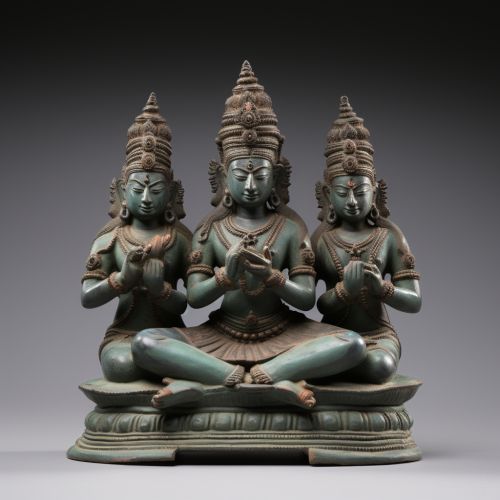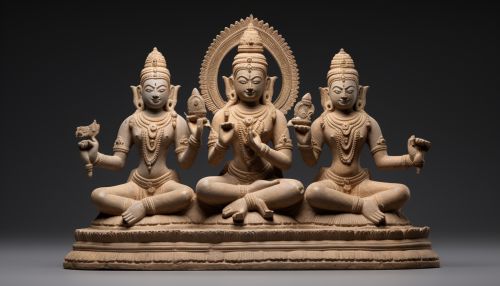Trimurti
Overview
The Trimurti is a concept in Hinduism that represents the cosmic functions of creation, maintenance, and destruction. These functions are personified by the forms of Brahma the creator, Vishnu the maintainer or preserver, and Shiva the destroyer or transformer. These three deities have been called "the Hindu triad" or the "Great Trinity", often addressed as "the three forms or manifestations of the Supreme Being" that are collectively known as the Trimurti.
Origin and History
The concept of Trimurti is not explicitly mentioned in the early Vedic literature. The idea of divine triad is, however, very ancient, predating the Rigveda, and often invoked in the Brahmanas and the Upanishads. The concept is seen to have evolved over time, with the earliest representation of the Trimurti found in the Prambanan temple in Central Java, Indonesia, dating back to the 9th century CE.
Brahma
Brahma is the first god in the Hindu Trimurti. He is the creator of the universe and all living beings are said to have evolved from him. Brahma is often depicted with four faces and four arms, each face representing the sacred knowledge of the four Vedas. Despite being the creator, Brahma is not widely worshipped in the Hindu tradition, with very few temples dedicated to him.
Vishnu
Vishnu is the second god in the Hindu Trimurti. He is the preserver and protector of the universe. His role is to return to the earth in troubled times and restore the balance of good and evil. To date, he has been incarnated nine times, but Hindus believe that he will reincarnate one last time close to the end of this world. His most famous incarnations are Rama, Krishna and Buddha.
Shiva
Shiva is the third god in the Hindu Trimurti. He is the destroyer, and it is his role to destroy the universe in order to re-create it. Hindus believe his powers of destruction and recreation are used even now to destroy the illusions and imperfections of this world, paving the way for beneficial change. Shiva is known to have a passionate nature and is often associated with the ancient Indian tradition of asceticism.
Philosophical Interpretations
The philosophical understanding of the Trimurti varies among the different Hindu philosophies. The Shaiva Siddhanta interpretation sees Brahma, Vishnu, and Shiva as manifestations of the supreme being, Paramasiva. The Vaishnavite interpretation, on the other hand, sees Vishnu as the ultimate god, with Brahma and Shiva subordinate to him. The Smarta interpretation sees all gods as different aspects of the same supreme reality, Brahman.
Cultural Influence
The Trimurti concept has had a significant influence on Hindu art and culture. It is often depicted in temple sculptures and theatrical performances. The concept has also influenced the structure of Hindu epics and Puranas, which often depict the three gods working together to maintain cosmic harmony.
See Also


